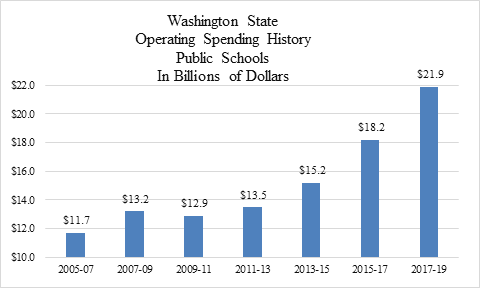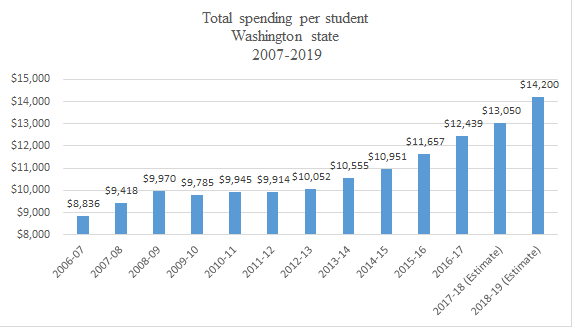Last week Washington state lawmakers announced that, with passage of the 2017-19 budget, they have met the education spending levels called for under the McCleary school funding lawsuit. Since the suit started in 2007, the people of Washington have nearly doubled the amount of tax money they devote to public education.
The justices of the state supreme court will soon decide whether they will accept the legislature’s increased level of funding for education. The primary flaw in the McCleary ruling is that, having asserted control over education policy in 2012, the justices failed to identify the dollar amount they would consider as “constitutional” under their ruling.
The legislature doesn’t know either, so the answer they came up with is “a lot.” Lawmakers have increased per-student spending from about $8,800 to $14,200 since the lawsuit started.
The new 2017-19 state budget provides the third successive multi-billion dollar increase to K-12 school spending since the January 2012 McCleary decision. Overall, in the decade since the McCleary case started, the legislature has nearly doubled funding for K-12 schools.
Governor Inslee says the legislature has met its obligation to fund the schools:
“I am proud to sign a historic budget that fully funds our schools... This budget, at long last, meets our constitutional obligations to fully fund basic education, and addresses the responsibilities we have under the McCleary decision to equitably fund our schools.”
Governor Inslee is right. In just 10 years the state of Washington has lavished money on public school administrators, as shown in the state-reported data below.

State public education spending has nearly doubled since the McCleary lawsuit started. Source: Washington State Historical Spending Trends, Legislative Evaluation and Accountability Program, Office of Financial Management, at https://fiscal.wa.gov/SpendHistFund.aspx.
State Attorney General Bob Ferguson (D) agrees the legislature has properly funded schools:
“The State has remedied the constitutional deficiencies in the prior funding system.
“The State therefore has complied with its duty under article IX, section 1 of the Washington Constitution to make ample provision for the education of all children residing within the State, as set out in this Court’s 2012 decision. The Court should find the State in compliance with article IX, section 1, release the State from its contempt orders, and terminate this appeal.”
Taxpayers also provide local levy and federal taxes, in addition to state funds. This graph shows total funding per student provided by taxpayers, from all state, local and federal resources:
Per-student spending has skyrocketed in recent years, and is now more than the tuition at many private schools.
Separate state reports show that adding more money to the schools does not improve student learning. So it is not clear what this agonizing ten-year process accomplished, other than funneling a great deal of money to interests that benefit from the current monopoly school system, particularly unions.
Still, Democrats, Republicans, the Governor and the Attorney General all recognize the McCleary process has run its course. For good or ill, this long-running, costly and controversial legal dispute is over. The legislature can now take education policy back from the courts and return to normal management and funding of public schools.
What remains is for lawmakers to break out of old thinking and find ways to expand family choice in education, so parents have access to the full range of options that serve the learning needs of all children in our state.





